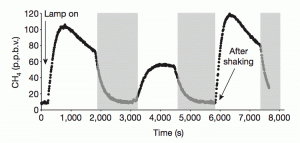Methane gas, which can arise from both biological and geological sources, was detected in the Martian atmosphere by observations from Earth-based telescopes in 2003 and from the Mars Express orbiter (2004). As methane breaks down relatively quickly under Martian conditions, the amount measured implies a release of 200 to 300 tons of methane each year. The findings have caused much speculation about possible sources, including micro-organisms.

UNDER THE UV LAMP, methane (CH4) emerges from samples of the carbon-bearing Murchison meteorite in a test chamber flushed with nitrogen gas. The scale reads in parts per billion by volume, and the gray bands show calibration measurements of the nitrogen. (Image taken from Figure 1 in the paper.)
However recent experiments by a team of researchers led by Frank Keppler (Max Planck Institute for Chemistry, Germany) suggest a natural way to create Martian methane without biology. They published their report in Nature.
Keppler’s team exposed to ultraviolet light pieces of a carbonaceous meteorite that fell near the town of Murchison in Australia in 1969. The Murchison meteorite is a type CM2, one of the most chemically primitive meteorite types known. The researchers’ experiments found that as UV light struck carbon compunds in the meteorite, it decomposed the compounds and released methane gas.
“Methane is produced from innumerable small micrometeorites and interplanetary dust particles that land on the Martian surface from space,” says Keppler. The energy to power the extraction of methane, he says, comes from intense solar ultraviolet radiation, which reaches the surface largely unhindered by the thin atmosphere.
The UV reaction is also highly sensitive to temperature, the team found. As temperatures on Mars vary from –143° C (–225° F) at the poles to +17° C (63° F) at the equator, the scientists ran the experiment on samples at similar temperatures. The warmer the temperature, the more methane the meteoritic fragments released.
This temperature dependence also fits the different methane concentrations detected at various locations in the Martian atmosphere. In infrared spectra, the largest concentration of methane was found in the equatorial region, the warmest place on the planet.








